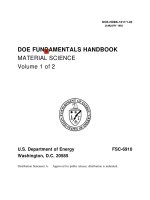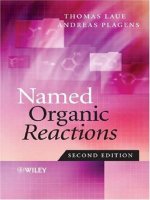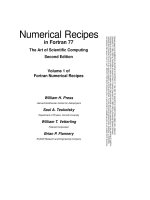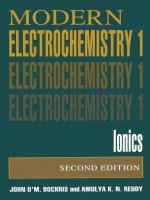Organic reactions vol 1 adams
Bạn đang xem bản rút gọn của tài liệu. Xem và tải ngay bản đầy đủ của tài liệu tại đây (4.08 MB, 396 trang )
Organic Reactions
VOLUME I
EDITORIAL
BOARD
ROGER ADAMS, Editor-in-Chief
WERNER E. BACHMANN
JOHN R. JOHNSON
LOUIS F. FIESER
H. R. SNYDER
ASSOCIATE
EDITORS
A. H. BLATT
CHARLES R. HAUSER
F. F. BLICKE
MARLIN T. LEFFLER
NATHAN L. DRAKE
ELMORE L. MARTIN
REYNOLD C. FUSON
RALPH L. SHRINER
LEE IRVIN SMITH
NEW YORK
JOHN WILEY & SONS, INC.
LONDON: CHAPMAN & HALL, LIMITED
1942
COPYRIGHT, 1942
BY
ROGER ADAMS
All Bights Reserved
This book or any part thereof must not
be reproduced in any form without
the written permission of the publisher.
PRINTED IN THE UNITED STATES OF AMERICA
PREFACE
In the course of nearly every program of research in organic chemistry
the investigator finds it necessary to use several of the better-known
synthetic reactions. To discover the optimum conditions for the application of even the most familiar one to a compound not previously subjected to the reaction often requires an extensive search of the literature; even then a series of experiments may be necessary. When the
results of the investigation are published, the synthesis, which may have
required months of work, is usually described without comment. The
background of knowledge and experience gained in the literature search
and experimentation is thus lost to those who subsequently have occasion to apply the general method. The student of preparative organic
chemistry faces similar difficulties. The textbooks and laboratory manuals furnish numerous examples of the application of various syntheses,
but only rarely do they convey an accurate conception of the scope and
usefulness of the processes.
For many years American organic chemists have discussed these problems. The plan of compiling critical discussions of the more important
reactions thus was evolved. Volume I of Organic Reactions is a collection of twelve chapters, each devoted to a single reaction, or a definite
phase of a reaction, of wide applicability. The authors have had experience with the processes surveyed. The subjects are presented from
the preparative viewpoint, and particular attention is given to limitations, interfering influences, effects of structure, and the selection of
experimental techniques. Each chapter includes several detailed procedures illustrating the significant modifications of the method. Most
of these procedures have been found satisfactory by the author or one
of the editors, but unlike those in Organic Syntheses they have not been
subjected to careful testing in two or more laboratories. When all
known examples of the reaction are not mentioned in the text, tables
are given to list compounds which have been prepared by or subjected
to the reaction. Every effort has been made to include in the tables
all such compounds and references; however, because of the very nature
of the reactions discussed and their frequent use as one of the several
steps of syntheses in which not all of the intermediates have been isolated, some instances may well have been missed. Nevertheless, the
vi
PREFACE
investigator will be able to use the tables and their accompanying bibliographies in place of most or all of the literature search so often required.
Because of the systematic arrangement of the material in the chapters and the entries in the tables, users of the book will be able to find
information desired by reference to the table of contents of the appropriate chapter. In the interest of economy the entries in the index
have been kept to a minimum, and, in particular, the compounds listed
in the tables are not repeated in the index.
The success of this publication, which will appear periodically in
volumes of about twelve chapters, depends upon the cooperation of
organic chemists and their willingness to devote time and effort to the
preparation of the chapters. They have manifested their interest already by the almost unanimous acceptance of invitations to contribute
to the work. The editors will welcome their continued interest and
their suggestions for improvements in Organic Reactions.
CONTENTS
CHAPTER
PAGE
1 THE REFORMATSKY REACTION—Ralph L Shnner
1
2 THE ARNDT-EISTERT SYNTHESIS—W. E. Bachmann and W S Struve
38
3. CHLOROMETHYLATION OF AROMATIC COMPOUNDS—Reynold C Fuson and
C. H. McKeever
63
4. THE AMINATION OF HETEROCYCLIC BASES BY ALKALI AMIDES—Marhn
T.
Leffler
91
5. T H E BUCHERER REACTION—Nathan L Drake
105
6. THE ELBS REACTION—Louts F. Fieser
129
7. THE CLEMMENSEN REDUCTION—Elmore L Marhn
155
8. THE PERKIN REACTION AND RELATED REACTIONS—John R. Johnson
210
9. T H E ACETOACETIC ESTER CONDENSATION AND CERTAIN RELATED REACTIONS—Charles R. Hauser and Boyd E Hudson, Jr
10. THE MANNICH REACTION—F. F. Bhcke
11. THE PRIES REACTION—A. H. Blatt
266
. 303
.. 342
12 THE JACOBSEN REACTION—Lee Irmn Smith
INDEX
370
. . 385
vu
CHAPTER 1
THE REFORMATSKY REACTION
RALPH L. SHRINER
Indiana University
CONTENTS
PAGE
2
GENERAL CONSIDERATIONS
Relative Reactivities of Reagents
Side Reactions
4
4
THE USE OF THE REFORMATSKY REACTION
5
Lengthening the Carbon Chain
Synthesis of Arylacetic Acids
Synthesis of /3-Ketoesters
6
9
9
DEHYDRATION OF THE /3-HYDROXYESTERS
11
Table I
SELECTION OF EXPERIMENTAL CONDITIONS.
13
PROCEDURES
14
Ethyl /3-Phenyl-/3-hydroxypropionate
Ethyl 1-Hydroxycyclohexylacetate
16
17
Ethyl a-Methyl-/3-phenyl-j3-hydroxybutyrate
Dimethyl Ester of 7-Methoxy-2-methyl-2-carboxy-l-hydroxy-l,2,3,4-tetrahydrophenanthrene-1-acetic Acid
17
EXAMPLES OF THE REFORMATSKY REACTION
Aldehydes. Table II
Ketones. Table III
Esters. Table IV
Substituted Amides
VARIATIONS OF THE REFORMATSKY REACTION
Use of Halogen Compounds Other Than a-Haloesters
Table V
Use of Compounds Other Than Carbonyl Derivatives
18
19
20
24
33
34
34
34
35
36
2
THE REFORMATSKY REACTION
GENERAL CONSIDERATIONS
The reaction which takes place between a carbonyl compound such as
an aldehyde, a ketone, or an ester and an a-haloester in the presence of
zinc is commonly known as the Reformatsky reaction.1 It represents an
extension of the reactions of carbonyl compounds with a dialkylzinc or
an alkylzinc halide, but possesses the advantage that the isolation of the
organozinc compound is unnecessary. The process creates a new carbon-carbon linkage and appears to involve the following steps.2
1. Formation of an organozinc halide.
X—C—CO2R+ Zn -> X—Zn—C—CO2R
[1]
(X represents Cl, Br, I; R, is an alkyl group.)
2. Addition to the carbonyl group of the aldehyde or ketone.
_ C = O + X—Zn—C—CO2R -* —C—C—CO2R
[2]
3. Decomposition by dilute acids.
XZnO
OH
—C—C—CO2R + HX -> —C—C—CO2R + ZnX2
[3]
Thus an aldehyde or a ketone leads to a /3-hydroxyester (III) as the
final product. Subsequent or simultaneous dehydration may produce
an unsaturated ester.
When an ester is used instead of an aldehyde or ketone the addition
product IV is formed.
XZnO
_ C = O + X—Zn—C—CO2R -» —C—C—CO2R
I
1
2
I
II
o
0
R'
R'
IV
Reformatsky, Ber., 20, 1210 (1887).
Reformatsky, J. prakt. Chem., 54, 469 (1896).
GENERAL CONSIDERATIONS
3
If this addition complex is stable, then the product obtained by hydrolysis of the reaction mixture is a /3-ketoester.
XZnO
O
—C—C—CO2R + HX -> —C—C—CO2R + R'OH + ZnX2
1 I
I
0
R'
IV
V
If the addition product decomposes spontaneously, the /3-ketoester (V)
may again be the final product, or if the keto group in this ketoester is
reactive and an excess of the organozinc halide (I) is present further
reaction may take place as in equations 2 and 3 above.
OZnX
—G
0
x
C—CO2R —» —C—C—CO2R + Zn
NAP'
0 R
OR'
Evidence for the existence of the organozinc halide (I) as an intermediate was provided by G. Dain, 3 who isolated and analyzed the following compounds.
ZnBr
ZnBr
(CH3)2CCO2C2H6
(CH3)2CHCHCO2C2H6
Three addition products corresponding to the complex II were also
obtained.
OZnBr
OZnBr
C6H6CHCHCO2C2H6
C6H6CHCHCO2C2H6
I
I
OZnBr
C6H6CH—C—CO2C2H6
/
\
CH 3
CH(CH3)2
CH 3
CH 3
These complexes, therefore, parallel the intermediates formed in the
well-known reactions involving the Grignard reagent or similar organometallic halides and carbonyl compounds. Indeed, magnesium may be
used in place of zinc (p. 16), and apparently the intermediate complexes
are analogous. Grignard reagents cannot be prepared from a-haloesters
and magnesium alone; hence the Reformatsky reaction offers a pro3
Dain, / . Russ. Phys. Chem. Soc, 28, 593 (1896).
4
THE REFORMATSKY REACTION
cedure by which the equivalent of a Grignard reagent from an a-haloester
is available for synthetic work. In the subsequent discussion these
intermediates will not always be written and only the reactants and
main products will be shown. It is to be understood, however, that the
steps shown above are always involved.
Relative Reactivities of Reagents. The order of reactivity of carbonyl
compounds in the Reformatsky reaction is RCHO > R2CO > RCCV
C2H5. The order of reactivity of the haloacetates is ICH2CO2C2H5 >
BrCH2C02C2H5 > C1CH2CO2C2H5. The a-chloroacetic esters often
react slowly or not at all, and the a-iodoesters are not readily available.
Consequently, most Reformatsky reactions have been carried out with
the a-bromoesters. Esters containing a secondary or tertiary a-chlorine
atom are much more reactive than the corresponding primary derivatives
and in some cases are reported to give good yields. The three types of abromoesters appear to react equally well.
Side Reactions. Various side reactions may be expected whenever the
Reformatsky reaction is carried out. The intermediate organozinc
halide may add to the carbonyl group of the a-haloester used as the
reagent; for example, Hann and Lapworth4a have reported that zinc
and ethyl bromoacetate react to produce ethyl 7-bromoacetoacetate.
OZnBr
2BrCH2CO2C2H6 + Zn -> BrCH2C—CH2CO2C2H6
OC2H6
i
BrCH2C0CH2CO2C2H6 + C2H6OZnBr
Since aldehydes and ketones possess far greater carbonyl reactivity than
the ester group, this side reaction is not important when aldehydes and
ketones are used. Moreover, its significance may be minimized by using
an excess of the bromoester and adding the latter in successive portions.
A common side reaction is the coupling of the haloester by the zinc.
CH2CO2C2H6
2BrCH2CO2C2HB + Zn —> ZnBr2 + |
CH2CO2C2Hs
When aliphatic aldehydes or aliphatic or alicyclic ketones are used,
these may undergo aldolization under the influence of the zinc salts.
*"• Hann and Lapworth, Proc. Chem. Soc., 19, 189 (1903).
THE USE OF THE REFORMATSKY REACTION
R
2RCH2CHO
ZnBra
> RCH2CHOHCHCHO
R
RCH2CH=CCHO + H2O
O
Not only does aldolization use up the aldehyde or ketone, but also the
dehydration of the aldol produces water which decomposes the intermediate organozinc halide (I).
!
I
X—Zn—C—CO2R + H2O -> H—C—CO2R + Zn(OH)X
1
1
1
The organozinc compound may also induce enolization.4!l
ZnBr
OZnBr
RCOCH2R+ C 2 HBCHCO 2 C 2 HB -» R—C=CHR + CH 3 (CH 2 ) 2 CO 2 C 2 HB
Subsequent hydrolysis of the bromozinc enolate regenerates the original
ketone. This reaction accounts for the recovery of appreciable amounts
of the starting material and the presence of ethyl n-butyrate among the
reaction products.
THE USE OF THE REFORMATSKY REACTION
From a synthetic point of view the Reformatsky reaction not only
constitutes a method for preparing /3-hydroxyesters and the corresponding unsaturated esters and acids but also is a valuable procedure for
lengthening the carbon chain by two carbon atoms. The chain may be
branched on the a-, $-, or a- and /3-carbon atoms by proper choice of
reactants. Since the product contains the carbethoxy group, it is possible by a proper sequence of reactions to repeat the chain-lengthening
process. Several examples have been chosen to illustrate the utility of
the condensation and to point out the part played by the Reformatsky
reaction in a synthetic sequence.
* Newman, J. Am. Chem. Soc, 62, 870 (1940).
6
THE REFORMATSKY REACTION
Lengthening the Carbon Chain. Lengthening the Carbon Chain of an
Aldehyde without Branching the Chain.
R CHO
• RCHOHCH2CO2C2H6
Zn
Dehydration. *
RCH=CHCO 2 C 2 H 5
Reduction (catalytic)
Hydrogenolysis
RCH2CH2COC1
xvO H 2C H 2C H 2O H
Oxidation
RCH2CH2CONH2
RCH2CH2CHO
RCH2CH2CN
The process may be repeated, leading to R(CH 2 )4CH0.
Lengthening the Carbon Chain with Branching on the a-Carbon Atom.
R'
R'
RCHO + BrCHCO2C2HB
I
RCHOHCHCO2C2H6
^
R'
RCH2CHCO2C2H6
R'
RCH=CCO 2 C 2 H 6
Use of the sequence of reactions outlined under the first example to
convert the ester group into an aldehyde group leads to the synthesis
of branched-chain esters of the following type.
R'
R[—CH2—CH— ]„—CO2C2H6
* The dehydration of /3-hydroxyesters frequently produces a mixture of a,(3- and /3,yunsaturated esters (see p. 12). Both may be reduced catalytically to the saturated ester.
LENGTHENING THE CARBON CHAIN
Lengthening the Carbon Chain with Branching on the (5-Carbon Atom.
a'
a'
R _ C = O + BrCH2CO2C2HB -^-> R—C—CH2CO2C2HB
OH
R'
R—C=CHCO 2 C 2 H 6
I
a'
The ester group of the final product may be converted into a keto
group by the following reactions.
R'
R'
R,—CHCX12CO2C2H5
R'
-^
R—CHCH2CO2H
f i
R'
R—CHCH2CO <^ — R—CHCH2COC1
Repetition of these sequences of reactions leads to the preparation of a
second type of branched-chain ester.
R'
]n—CO2C2H6
The nature of the R' group is determined by the starting ketone and
the zinc alkyl used in converting the acid chloride into the final ketone.
The R' groups may be alike or different.
Lengthening
Atoms.
the Carbon Chain with Branching
a'
R"
I
I
R — C = O + BrCHCO 2 C 2 H B
Zn
on Both a- and
R' R "
I I
>• R — C — C H C O 2 C 2 H B
OH
a' R"
R—C=CCO2C2H6
R'
R"+
R—CH—CHCO2C2H5
fi-Carbon
THE REFORMATSKY REACTION
The nature of the R and R' groups is determined by the ketone and
that of the R" group by the haloester.
Lengthening the Carbon Chain with Double Branching on the a-Carbon
Atom.
R'
R'
RCHO- BrCCO 2 C 2 Hs
R'
R—C=O •
Zn
R"
R'"
RCH—C—CO2C2H6
OH R"
R' R'"
BrCCO 2 C 2 H 6
Zn
R—C—C—CO2C2H6
OHR"
R"
Occasionally, hydroxyesters of this type may be dehydrated to /3,7unsaturated esters which can then be reduced to the saturated esters.
However, conversion of these a,a-disubstituted-|3-hydroxyesters to the
saturated esters is usually best effected by refluxing with phosphorus and
hydriodic acid.
These five general types of reactions therefore constitute methods for
synthesizing straight-chain and branched-chain hydroxyesters and unsaturated and saturated esters and acids.Whether or not the Reformatsky reaction is the best method for
lengthening a given carbon chain depends on a number of factors. For
example, cinnamic acid may be prepared by any of the following reactions.
Perkin reaction
(CH3CO)2O
C6H6CHO
Claisen condensation
CH3CO2C2H6
(C6H6N)
C 6 H 6 CH=CHCO 2 H
• C6H6CH==CHCO2C2H6
i
C6H 6 CH=CHCO 2 H
Reformatsky reaction
CeHaCHO + BrCH2CO2C2H6
74
72
OH
Zn
• CeHsCH—CH2CO2C2H6
2
i
CeH 6 CH=CHCO 2 C 2 H s
I
Knoevenagel condensation
CEUCHO + CH2(CO2H)2
Yield, %*
80
C 6 H 6 CH=CHCO 2 H
NH 3
64
57
55
• C6H 6 CH=C(CO 2 H) 2
I-co2
C6H B CH=CHCO 2 H
80
*• Thesefiguresrepresent the over-all yields of the products shown, based on benzaldehyde.
SYNTHESIS OP 0-KETOESTERS
On the basis of yields alone, the Knoevenagel or Perkin condensation
would be preferred for preparing cinnamic acid. From an economic
point of view, the reaction chosen would depend on the relative cost of
the reagents and the time involved in the preparation. The Reformatsky
reaction would not be selected.
However, in the synthesis of an unsaturated acid with branching on
the /3-carbon atom (C6H5C=CHCO2H) from the ketone (C6H5COR)
the Reformatsky is the only method of these four which will give good
yields; the Perkin reaction fails to take place, the Claisen condensation
leads to an entirely different product (a 1,3-diketone), and the Knoevenagel condensation gives low yields for small R groups and fails if R is large.
Branching of the chain on both a- and /3-carbon atoms can be accomplished only by the Reformatsky method.
Synthesis of Arylacetic Acids. The Reformatsky reaction is also
particularly well adapted to the synthesis of arylacetic acids or their
esters. Thus, ketones such as 1-tetralone or 1-ketotetrahydrophenanthrene5 give hydroxyesters which are readily dehydrated to dihydroarylacetic esters. The latter may be easily dehydrogenated to the aromatic
compounds.
CH2CO2C2H6
-OH
CH2CO2CH8
CH2CO2C2H6
CH2CO2C2H6
CH2CO2CH3
CH2CO2CHa
Synthesis of /3-Ketoesters. Very few applications of the Reformatsky
reaction to the synthesis of /3-ketoesters by reactions involving the carbonyl group of an ester are recorded. Ethyl 7-bromoacetoacetate is
formed by the action of zinc or magnesium on ethyl bromoacetate.40
Hamel6 reported 56% yields of ethyl y-chloroacetoacetate by the action
of amalgamated magnesium on ethyl chloroacetate. Ethyl y-ethoxyacetoacetate has been prepared in 10 to 33% yields from ethyl ethoxy6
6
Bachmann, J. Org. Chem., 3, 434 (1938).
Hamel, Bull. soc. Mm., [4] 29, 390 (1921); Stolle, Ber., 41, 954 (1908).
10
THE REFORMATSKY REACTION
acetate and ethyl bromoacetate 7 by using amalgamated zinc. If ethyl
a-bromopropionate is used, the a-methyl derivative is produced.8
0
C2H6OCH2C—OC2HB + BrCH 2 CO 2 C 2 H 6
OZnBr
C 2 H 6 OCH 2 C—CH 2 CO 2 C 2 H 6
OC 2 H 6
O
II
C 2 H 6 OCH 2 C—CH 2 CO 2 C 2 H 5
Ethyl 3,4-diketoadipate 9 has been obtained from ethyl oxalate, ethyl
chloroacetate, and zinc.
CO2C2HB
COCH2CO2C2H6
Z
|
+ 2C1CH2CO2C2H6
>• |
CO2C2HB
COCH2CO2C2H6
On the other hand, ethyl a-bromoisobutyrate is reported to react with
ethyl oxalate to form ethyl a ; a-dimethylmalate. 10 I t is evident that
reduction takes place during this reaction.
Br
CO2C2H6
I
HOCHCO 2 C 2 H 6
Zn
I
+ (CH 3 ) 2 C—CO 2 C 2 H 6 —^±
I
CO 2 C 2 H 6
(CH 3 ) 2 C—CO 2 C 2 H 6
T h e chief product from ethyl formate, ethyl chloroacetate, a n d zinc is
ethyl trimesate.11 Ethyl formate undergoes the normal Reformatsky
reaction to produce the aldehydoester which then trimerizes.
O
OZnCl
C2HBO—C—H + C1CH2CO2C2H6 -^-> C2H6O—C—CH2CO2C2HB
H
O=C—CH2CO2C2H6
|
H
'Sommelet, Bull. soc chim., [4] 29, 553 (1921); Compt. rend., 164, 706 (1912).
Johnson, J. Am. Chem. Soc, 35, 582 (1913); Johnson and Chernoff, / . Am. Chem. Soc,
35, 585 (1913); 36, 1742 (1914).
9
Fittig and Daimler, Ber., 20, 202 (1887).
10
Rassow and Bauer, Ber., 41, 963 (1908).
11
Reformatsky, / . Russ. Phys. Chem. Soc, 30, 280 (1898); J. prakt. Chem., 54, 477
(1896).
8
DEHYDRATION OF THE 0-HYDROXYESTERS
11
With ethyl a-bromopropionate, the presence of the a-methyl group
in the intermediate aldehydoester prevents the trimerization. Hence a
second Reformatsky reaction occurs leading to ethyl 2,4-dimethyl-3hydroxyglutarate.12 Ethyl a-bromoisobutyrate, ethyl formate, and zinc
react in a similar fashion to produce ethyl 2,2,4,4-tetramethyl-3-hydroxyglutarate.13
Oxidation* of the /3-hydroxyesters, obtained by the Reformatsky reaction on aldehydes, by means of the calculated amount of chromic
acid in glacial acetic acid as the solvent, produces ^-ketoesters in low
yields (30-50%).
RCHOHCH2CO2CH3 -^% RCOCH2CO2CH3
Thus, /3-ketoesters with no a-substituents may be obtained. This is
useful since the Claisen condensation of esters (other than ethyl acetate)
yields a-substituted /J-ketoesters (see Chapter 9).
DEHYDRATION OF THE /3-HYDROXYESTERS
If the temperature of the reaction mixture is high it occasionally
happens that the product from the Reformatsky reaction is the unsaturated ester. However, if the reaction is run in the usual solvents, such
as ether or benzene (p. 15), the chief constituent of the reaction mixture
is the hydroxyester. Because of their tendency to lose water during distillation or saponification,14 the /?-hydroxyesters and their derivatives can
sometimes be isolated in the pure state only with difficulty and in poor
yields, whereas dehydration of the crude reaction mixtures leads to
higher yields of the unsaturated products.
Dehydration may be accomplished by heating the ^-hydroxyester
with acetic anhydride, acetic anhydride and acetyl chloride,15 fused
potassium acid sulfate,16 85% formic acid,17 anhydrous formic acid,5' 18'19
zinc chloride in acetic acid,20 or sulfuric acid21 of various strengths (20 to
*See p. 22, reference 48.
n
Reformatsky, Ber., 28, 3262 (1895).
"Blaise, Compt. rend., 126, 1808 (1898).
14
Schroeter, Ber., 37, 1090 (1904); 40, 1589 (1907).
"Stoermer and Frederici, Ber., 41, 324 (1908).
"Wallach, Ann., 365, 255 (1909).
" Rupe, Ann., 369, 321 (1909).
18
Cook, J. Chem. Soc, 2524 (1931); Bachmann and Edgerton, J. Am. Chem. Soc, 62,
2971 (1940).
19
Bergmann and Bograchov, / . Am. Chem. Soc, 62, 3017 (1940).
"Wallach, Ann., 314, 147 (1901); Tetry, Bull. soc. chirn., [3] 27, 600 (1902).
21
Jaworsky and Reformatsky, Ber., 35, 3633 (1902).
12
THE REFORMATSKY REACTION
65%); or by refluxing a benzene solution of the /3-hydroxyester with
iodine,22 acetic anhydride, acetic anhydride and sodium acetate,23 phosphorus pentoxide,24 phosphorus oxychloride,24'26 or thionyl chloride and
pyridine.24'26 Passing dry hydrogen chloride through the /3-hydroxyester at 90-100° followed by distillation is also a very satisfactory
method 27 (90-95% yields) of dehydration.
For many years it had been assumed that the product of the dehydration reaction was the conjugated a,/3-unsaturated ester. When the /3hydroxyl group is secondary, or when an aryl group is attached to the
/3-carbon atom, the chief product (and in many cases the only one isolated) is, indeed, the a,/3-unsaturated ester or acid.
ArCHCH2CO2H -> ArCH=CHCO2H
OH
However, when the hydroxyl group is tertiary the structure of the
dehydration product is determined by the nature of the substituents.
The a,|8-unsaturated ester is the chief product when an aryl group or two
methyl groups are attached to the /3-carbon atom%
R
R
Ax—C—CH2CO2C2HB -> Ar—C=CHCO2C2H6
OH
CH3
CH3
CH 3 —C—CH 2 CO 2 C 2 H 6 - * CH 3 —C=CHCO 2 C 2 H 6
AH
However, when one of the alkyl groups is other than methyl then
both a,;8- and /3,7-unsaturated esters are produced.
R
R
RCH2—C==CHCO2C2H6
RCH2—C—CH2CO2C2HB
I
OH
\
B
I
RCH=C—CH 2 CO 2 C 2 H B
22
Hibbert, J. Am. Chem. Soc, 37, 1748 (1915).
" R u p e and Busolt, Ber., 40, 4537 (1907).
24
Kon and Nargund, J. Chem. Soc, 2461 (1932); Phalnikar and Nargund, J. Indian
Chem. Soc, 14, 736 (1937).
26
Lindenbaum, Ber., 50, 1270 (1917).
26
Darzens, Compt. rend., 152, 1601 (1911).
27
Natelson and Gottfried, J. Am. Chem. Soc, 61, 970 (1939).
DEHYDRATION OF THE 0-HYDROXYESTERS
13
The proportion of the two isomeric esters depends on the reagent used
and on the structure of the compound. The dehydration of a number of
/3-hydroxyesters by means of four dehydrating agents has been studied
by Kon and Nargund.24 The total yield of the mixture of a,/3- and f},yunsaturated esters was 80-95%. In Table I is shown the percentage
of the total product which was the a,/3-unsaturated ester.
TABLE I
DEHYDRATION OF /S-HYDROXYESTERS
[Percentage of
P2O6
POCI3
SOC12
(fused)
KH8O4
39
62
53
57
23
68
50
63
24
51
31
51
28
43
33
28
19
43
62
54
30
58
50
38
CH 3
C 2 H 6 —C—CH 2 CO 2 C 2 H 6
OH
C2H6
C 2 H 6 —C—CH 2 CO 2 C 2 H 6
OH
CSH7
CH7—C—CH 2 CO 2 C 2 H 6
OH
C 2 H 6 CH 3
C 2H 6"*—O
OHCO 2C 2H 6
AH
o<
0H
^—'
CH2CO2C2HS
*—/
CH2CO2C2H6
It is occasionally possible to obtain either one of the isomeric dehydration products by proper choice of the experimental conditions. For
example, dehydration of ethyl 1-hydroxycyclohexylacetate with acetic
anhydride followed by saponification gives A'-cyclohexenylacetic acid;
14
THE REFORMATSKY REACTION
if the ester is first saponified and the 1-hydroxycyclohexylacetic acid is
dehydrated with acetic anhydride the chief product is cyclohexylidene
acetic acid.16 In syntheses of saturated esters or acids it is unnecessary
to separate the a,/3- and /3,7-esters or acids before reduction.
Sometimes cleavage occurs as a side reaction in dehydration of /3hydroxyacids. Thus heat causes the decomposition of a-(l-hydroxy-3methylcyclohexyl) propionic acid.16
OH
I
CH 3
j
\ ^
+CH 3 CH 2 CO 2 H
Sulfuric acid causes the cleavage of a,a-dialkyl-j3-hydroxy acids.11
R
CH3CH—C—CO2H
H2S 4
° > CH3CHO + R2CHCO2H
OH R
"Hot concentrated alkalies may also cause cleavage of the molecule in
certain instances.
CO2CH3
CH2CO2CH3
OH
CH3O
In order to obtain the unsaturated compound and avoid this cleavage it
is essential to dehydrate before hydrolyzing. 28 ' 29
SELECTION OF EXPERIMENTAL CONDITIONS.
PROCEDURES
2 30
In the earlier experiments, ' the a-haloester, carbonyl compound,
and zinc dust were mixed at room temperature and cooled in order to
moderate the initial reaction which may cause a considerable temperature
rise (60° to 120°). The mixture was allowed to stand at room temperature for periods ranging from two days to three months. After a final
warming to 60-70° for two to three hours the mixture was decomposed
with dilute acid. The ester was separated or extracted by a solvent,
dried, and distilled in vacuum.
28
29
30
Baohmann, Cole, and Wilds, J. Am. Ckem. Soc, 62, 824 (1940).
Baohmann and Wilds, J. Am. Chem. Soc, 62, 2086 (1940).
Reformatsky and Plesconossoff, Ber., 28, 2838 (1895).
SELECTION OP EXPEEIMENTAL CONDITIONS
15
Control of the initial exothermic reaction may be accomplished by
addition of the zinc dust in portions to the other reactants or by the use
of a solvent. In most of the recent applications of the Reformatsky reaction a solvent has been employed. This permits better control of the
temperature and facilitates stirring. It is essential that the surface of
the zinc be kept clean. The formation of an oily product which coats the
zinc may stop the reaction. By the proper selection of the solvent
mixture it is often possible to keep the addition product in solution or to
cause it to crystallize so that it is more readily shaken from the metal by
the stirrer. The zinc may be suspended in a copper basket31 in order to
facilitate removal of the addition compounds.
By raising the temperature to the boiling point of the solution the
condensation can be effected in a much shorter time (usually one-half to
three hours). A prolonged reaction time32"'32b even at a low temperature
reduces the yield of /3-hydroxyester and increases the amount of highboiling by-products. The solvents used have been ethyl ether, butyl
ether, benzene, toluene, and xylene. A mixture of equal amounts of
benzene and toluene,27 which permits refluxing at temperatures between
90° and 105°, is especially advantageous when the carbonyl reagent is a
ketone. Somewhat lower temperatures (70-80°) are better when an aliphatic aldehyde is employed. However, where paraformaldehyde is
introduced into the reaction mixture as a source of formaldehyde, the
temperature must be high enough (80-100°) to cause depolymerization.
The reagents should be pure and dry. The apparatus should also be
clean and dry and protected from the moisture of the air. The observance of strictly anhydrous conditions not only improves the yield but
also reduces the induction period so that the reaction usually starts immediately. If difficulty is experienced, the addition of a few crystals of
iodine, a little amalgamated zinc, or a very little methylmagnesium
iodide may help in initiating the reaction. The copper complex of
ethyl acetoacetate has been used as a catalyst.33 Once started, the reaction is quite vigorous. For this reason, only a small portion of the
reactants should be used at the start and the bulk of the materials should
be added gradually. Since a-haloesters are lachrymators and skin irritants, precautions should be taken to avoid contact with them.
Zinc dust, zinc foil, granulated zinc, and mossy zinc have been used.
Variations in the quality of the zinc are responsible for differences of
opinion concerning yields, catalysts, and purification procedures. It is
81
Kohler and Gilman, / . Am. Chem. Soc, 41, 683 (1919).
Nieuwland and Daly, / . Am. Chem. Soc, 53, 1842 (1931).
S2b
Lipkin and Stewart, ibid., 61, 3295 (1939).
38
Kohler, Heritage, and Macleod, Am. Chem. J., 46, 221 (1911).
820
16
THE REFORMATSKY REACTION
desirable that the zinc be as pure as possible and have a fresh clean
surface. Any of the forms of zinc may be purified by washing rapidly
with 2% hydrochloric or hydrobromic acid, then with water, alcohol,
acetone, and absolute ether. The zinc is then warmed in a vacuum oven
at 100° for a short time and used immediately. A very active metal has
been obtained by immersing 30-mesh zinc in hot (100°) concentrated
sulfuric acid containing a few drops of nitric acid.34 After about fifteen
minutes the surface becomes bright and the acid is diluted with a large
volume of water. The zinc is washed with water and acetone and then
dried. Zinc foil may be cleaned with sandpaper and cut into small strips.
In certain instances amalgamated zinc and a mixture of zinc dust and
copper powder 32° have been used to effect the condensation. Cadmium
powder and mixed cadmium-cogper powder are ineffective.32" Magnesium has also been employed in place of zinc but usually results in
lower yields. For example, Zelinsky and Gutt 3B used magnesium to
effect the reaction between cyclic ketones anda-bromo-anda-iodo-esters.
The yields ranged from 20 to 50%, whereas other investigators report
that when zinc was employed the yields were 56 to 70% for the same
reactants. Kon and Nargund 2i obtained yields of 48% in the condensation of aliphatic ketones with a-chloroesters and magnesium.
Many different experimental conditions have been described in connection with the Reformatsky reaction, and inspection of the literature
reveals that there is no uniformity as regards the procedures. Hence
the yields shown in Tables II, III, and IV of the succeeding part do
not necessarily represent the highest attainable.
Four procedures have been chosen to illustrate the best methods available at the present time. These procedures not only illustrate the use of
different forms of zinc but also bring out other experimental variations.
One of the first three procedures should be selected when the reactants
are easily available. Procedure 1 illustrates the Reformatsky reaction on
an aldehyde, and procedures 2 and 3 on ketones. If the carbonyl compound is one which does not readily undergo self-condensation in the
presence of zinc salts, then higher yields can be obtained by treating it
repeatedly with zinc and the a-haloester as illustrated by procedure 4.
This method is especially advantageous when the ketone is available in
only small amounts.
Ethyl /8-Phenyl-/3-hydroxypropionate.36 In a clean, dry 500-cc. three-
necked flask fitted with a mechanical stirrer, a 250-cc. separatory funnel,
34
Fieser and Johnson, / . Am. Chem. Soc, 62, 575 (1940).
Zelinsky and Gutt, Ber., 35, 2140 (1902); Willatatter and Hatt, Ann., 418, 148
(1919).
36
Hauser and Breslow, Org. Syntheses, 21, 51 (1941).
36
PROCEDURES
17
and a reflux condenser, the upper end of which is protected by a calcium
chloride drying tube, is placed 40 g. (0.62 mole) of purified zinc dust or
granulated zinc. A solution of 83.5 g. (0.50 mole) of ethyl bromoacetate
and 65 g. (0.61 mole) of benzaldehyde in 80 cc. of dry benzene and 20 cc.
of absolute ether is placed in the separately funnel. About 15 cc. of this
solution is added to the zinc and the flask is warmed until the reaction
starts. The mixture is then stirred and the rest of the solution introduced at such a rate that gentle refluxing occurs, about one hour being
required. Refluxing is continued for an additional half hour. The
flask is then cooled in an ice bath and the contents poured into 300 cc. of
ice-cold 10% sulfuric acid with vigorous stirring. The acid layer is
drawn off and the benzene solution extracted twice with 50-cc. portions
of ice-cold 5% sulfuric acid. The benzene solution is washed once with
25 cc. of cold 10% aqueous sodium carbonate, then with 25 cc. of cold
5% sulfuric acid, and finally with two 25-cc. portions of water. The
combined acid extracts are washed with two 50-cc. portions of ether,
and the combined ether and benzene solutions are dried with 5 g. of
anhydrous magnesium sulfate or Drierite. After filtration, the solvent
is removed by distillation at atmospheric pressure on a steam bath and
the residue is fractionated in vacuum. The ester is collected at 151—
154711-12 mm. or 128-132°/5-7 mm. The yield is 59-62 g. (61-64%).
Ethyl 1-Hydroxycyclohexylacetate.27 A mixture of 800 cc. of benzene
and 700 cc. of toluene with 334 g. (2 moles) of ethyl bromoacetate and
196 g. (2 moles) of cyclohexanone is prepared. To 300 cc. of this mixture
in a 5-1. three-necked flask fitted with mechanical stirrer, condenser with
drying tube, and dropping" funnel is added 130 g. (2 moles) of zinc foil
which has been cleaned with sandpaper and cut in strips. A few crystals
of iodine are introduced, the stirrer is started, and heat is applied by
means of a boiling water bath. A vigorous reaction sets in. The
remainder of the reaction mixture is now added through the dropping
funnel at a rate designed to maintain gentle refluxing. Stirring is then
continued for two hours. Practically all the zinc dissolves. The mixture
is cooled and the condensation product is decomposed with dilute sulfuric acid (sufficient to dissolve all the zinc hydroxide). The benzenetoluene layer is separated, dried over anhydrous sodium sulfate, and distilled in vacuum. The product is collected at 86-89 °/2 mm. The yield
ranges from 219 to 278 g. (56-71%).
Ethyl a-Methyl-/3-phenyl-/?-hydroxybutyrate.37 A mixture of 110 g. of
acetophenone, 162 g. of ethyl a-bromopropionate, and 200 cc. of dry
benzene is placed in a 500-cc. separatory funnel inserted in one opening
37
Rupe, Steiger, and Fiedler, Ber., 47, 68 (1914); Burton and Shopee, J. Chem. Soc,
1160 (1935); Kloetzel, J. Am. Chem. Soc, 62, 1708 (1940).
18
THE REFORMATSKY REACTION
of a 2-1. three-necked flask fitted with a mechanical stirrer and a reflux
condenser.
In the flask is placed 70 g. of zinc dust (which has been cleaned with
5% hydrobromic acid, washed with water, alcohol, and acetone, and
dried). About 50 cc. of the mixture is added to the zinc dust, the stirrer
is started, and the mixture is heated by means of a steam bath until the
reaction starts. The remainder of the solution is added at such a rate
that gentle refluxing takes place. After the addition is complete, the
stirring and refluxing are continued for one hour. The mixture is then
cooled to room temperature and hydrolyzed by the addition of 400 cc. of
ice-cold 20% sulfuric acid. The benzene layer is separated and the
aqueous layer extracted with two 50-cc. portions of benzene. The combined benzene extracts are washed with a 50-cc. portion of cold 5% sulfuric acid, then with 25 cc. of 10% aqueous sodium carbonate, and
finally with two 25-cc. portions of water. The benzene solution is dried
with about 25 g. of anhydrous magnesium sulfate and the solvent removed by distillation from a steam bath. The residual oil is distilled in
vacuum. The ester is a colorless oil boiling at 134-135 °/9 mm. The
yield ranges from 150 to 161 g. (75-81%).
Dimethyl Ester of 7-Methoxy-2-methyl-2-carboxy-l-hydroxy-l,2,3,4tetrahydrophenanthrene-1-acetic Acid.28 To 2.5 g. of granulated zinc
(20-mesh, previously washed with dilute hydrochloric acid, water, acetone, and dried) and 0.07 g. of iodine in a mixture of 25 cc. of dry benzene (thiophene-free) and 25 cc. of anhydrous ether, are added 1.5 g. of
7-methoxy-2-methyl-2-carbomethoxy-l-keto-l,2,3,4-tetrahydrophenanthrene and 0.75 cc. of methyl bromoacetate. As the mixture is refluxed
on a water bath, the iodine color fades and the solution becomes cloudy.
After five to ten minutes a colorless addition product is deposited. Five
additions of 2.5 g. of zinc and a trace of iodine are made at forty-fiveminute intervals and an additional 0.75 cc. of methyl bromoacetate is
introduced after one and one-half hours. The mixture is refluxed for
a total of four hours, with occasional vigorous shaking to keep the zinc
free from adhering crystals.
The addition product is dissolved by adding a little acetic acid and
methanol, and the solution is decanted from the zinc into water. The
mixture is acidified with acetic acid. The ether-benzene layer is separated, the aqueous solution is extracted with benzene, and the combined extracts are washed with water and then with dilute aqueous
ammonia until no more color is removed. The residue obtained by
evaporation of the ether-benzene solution crystallizes readily from
methanol. The yield is 1.5-1.6 g. The product is recrystallized from
methanol containing a few drops of acetone; colorless leaflets, m.p.
EXAMPLES OF THE EEFORMATSKY REACTION
19
125-125.5° are obtained. By reworking the mother liquors a total
yield of 85-90% may be obtained.
EXAMPLES OF THE REFORMATSKY REACTION
In the tables which follow, a number of examples of the Reformatsky,
reaction have been collected to indicate its applicability in synthesis.
The tables are undoubtedly incomplete because the reaction frequently
has been used as merely one step in a synthesis and hence may not be
indexed as a Reformatsky process. As pointed out previously (p. 16),
because of the wide variations in the experimental conditions employed
by different investigators, the yields given are not necessarily the best
obtainable. For the same reason comparisons of yields reported by
different authors and often referred to different standards of purity are
not significant.
Aldehydes (Table II). Aliphatic and aromatic aldehydes, saturated
and unsaturated aldehydes undergo the reaction easily. The reaction
has been reported to fail with phenolic aldehydes,38" but recent work by
Connor m indicates that a reaction does take place.
8M
886
Reformatsky, J. prakt. Chem., 54, 469, 477 (1896).
Ralph Connor, private communication.
20
THE REFORMATSKY REACTION
^
""d^ ^
^
^
^
^
^*
^
£ ^
^^
O
^
CO
"^
S S S
s^ » ^s* > s^ s
88 85 •
t? & if t? {?
g s s s s
x P, x
_ CO • * l g "*__
3
^
sss
" « !
ID
o o o c o o o o
^ i ^ ^ ^ ,H H H
^» ^ i ^"> t*^ t ^ ^> t*i [>s
-o -a -a -6 •«
I
w
I
W
2
MOW
o—o
sg
woo
o W-
ooo
o o oo o
K ffi W W W
o o o o o









